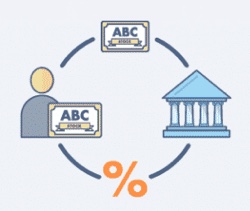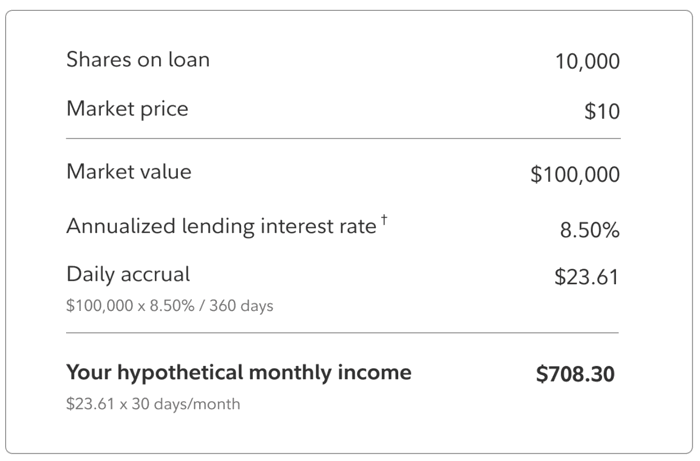 A few readers asked about “fully paid lending programs” offered by some brokerage firms. The premise is very intriguing: You lend out the stock shares you own and earn interest, all while keeping full “economic” ownership. You still get any upside or downside, you can still sell at any time, and your loans are backed by 100%+ collateral at a custodial bank. The broker finds borrowers, collects interest, and splits it with you (usually 50/50). Is this zero-effort free money? These programs can go by various names:
A few readers asked about “fully paid lending programs” offered by some brokerage firms. The premise is very intriguing: You lend out the stock shares you own and earn interest, all while keeping full “economic” ownership. You still get any upside or downside, you can still sell at any time, and your loans are backed by 100%+ collateral at a custodial bank. The broker finds borrowers, collects interest, and splits it with you (usually 50/50). Is this zero-effort free money? These programs can go by various names:
- ($250k min)
From Fidelity, here is a hypothetical example of how interest is calculated using an annualized lending rate of 8.50%.

Are the interest rates really that high? publishes “Short Borrow Fee Rates”, which they define as “the interest rate that must be paid by a short seller of [stock] to the lender of that security.” At the time of this writing, that fee was 0.25% APR for Tesla (TSLA) stock and 0.48% APR for Gamestop (GME) stock. That’s a far cry from 8.5%.
Still, if you have a large portfolio of stocks, even earning 0.10% in annual interest can become significant if it involves no extra effort.
Important factors to consider. After researching and comparing the details for each of these programs, here’s what I found.
- Understand the mechanics of this collateralized loan. Shares on loan are not covered under Securities Investor Protection Corporation (SIPC). Counterparty default is thus a risk, and this is why the SEC requires that the broker provides collateral at a minimum of 100% of the loan value to be held at a third-party custodian bank. If the broker can’t pay, then you can request the collateral. Still, it could be a potential headache if the broker doesn’t follow the rules properly, as warned by this .
-
You will get paid cash instead of your usual dividend payments while your security is on loan, and those two things may be taxed differently. Loan proceeds are usually taxed at your marginal tax rate (treated as ordinary income). Oftentimes, qualified dividends are taxed at a lower rate than ordinary income rates. Some brokers adjust for this difference, while many do not.
It is possible you might lose more money due to these tax differences than gained through lending income. - Eligibility requirements vary by broker. For example, TD Ameritrade doesn’t allow margin accounts so you’ll have to downgrade to a cash account first. This may affect your ability to trade immediately with unsettled funds. Meanwhile, Fidelity requires a minimum account value of $250,000.
- Participation doesn’t guarantee that your shares will be borrowed. Typically, securities that do get borrowed are in high demand or limited supply. Usually, they are used to facilitate short sales.
- Interest rates paid vary. Don’t get too excited by the interest rates quoted in their hypothetical examples. It’s unlikely you’ll be earning a 8% rate for an entire year.
- You give up proxy voting rights while your security is on loan.
I’ve never participated in such a program, but I have decided to try out the . I chose Fidelity for the following reasons:
Minimal counterparty risk. I view Fidelity as one of the most stable and reputable brokers, which means they are the least likely to have any issue paying back these loans. In addition, they have so much other business in high-compliance areas (401k plans, etc) that I trust that they will actually put up the proper collateral. Fidelity doesn’t need to take undue risks and is used to sweating the details.
Fully adjusting lost dividend income for taxes. Fidelity not only pays you any dividend income you miss due to them borrowing your stock, they adjust their payment higher to cover the maximum in potential taxes (26.98%). Perhaps another broker does this, but I didn’t see it spelled out explicitly and transparently like Fidelity. Otherwise, I might lose more money due to taxes than gained through lending income.
In order to mitigate the impact of cash-in-lieu payments to taxable accounts, Fidelity may return shares prior to a dividend record date. To help offset the potential tax burden associated with the receipt of cash-in-lieu payments in place of qualified dividends (as defined in the Jobs and Growth Tax Relief Reconciliation Act of 2003), Fidelity will credit participating taxable accounts with an additional credit adjustment equal to 26.98% of the qualified portion of the distribution. This adjustment will occur annually after all reclassification information is made available.4
Unfortunately, Merrill Edge and Vanguard do not seem to have such programs. I am currently in the process of transferring some securities into my Fidelity account to meet the minimum threshold.
If you have any experiences with these fully paid lending programs (good or bad) with any broker, please feel free to share in the comments. It’s been hard to find “real world” numbers on how much interest income to expect on a basket of mixed stocks.
“The editorial content here is not provided by any of the companies mentioned, and has not been reviewed, approved or otherwise endorsed by any of these entities. Opinions expressed here are the author’s alone. This email may contain links through which we are compensated when you click on or are approved for offers.”
from .
Copyright © 2004-2021 MyMoneyBlog.com. All Rights Reserved. Do not re-syndicate without permission.